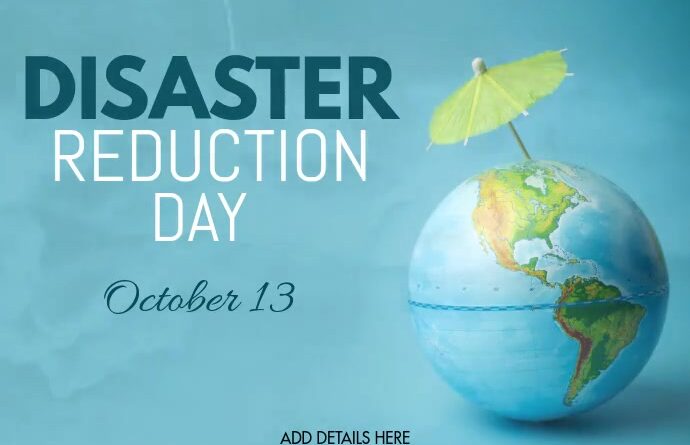
The International Day for Natural Disaster Reduction raises awareness and promotes actions to reduce the impact of disasters. Every year on October 13th, the International Day for Natural Disaster Reduction provides an opportunity to highlight the importance of disaster risk reduction and resilience.
This day aims to increase awareness about the measures individuals, communities, and governments can take to minimize the impact of natural disasters. Through education, public awareness campaigns, and community engagement, the goal is to reduce human and economic losses caused by disasters.
By recognizing the International Day for Natural Disaster Reduction, we can work towards building more resilient societies and taking proactive steps to mitigate the risks associated with natural hazards. In this introduction, we will explore the significance of this day and the efforts being made globally to reduce the devastating impact of natural disasters.
Why International Day For Natural Disaster Reduction Is Important?
The International Day for Natural Disaster Reduction holds immense significance in promoting disaster reduction, raising awareness, and enhancing preparedness globally. By dedicating a specific day, the world acknowledges the urgency and severity of natural disasters and the need to prioritize measures to reduce their impact on vulnerable communities.
The day serves as a platform to educate individuals, governments, and organizations about the potential risks, impacts, and ways to mitigate natural disasters. It fosters international cooperation and knowledge sharing, encouraging countries to collaborate and exchange best practices in disaster risk reduction.
Through various initiatives, the International Day for Natural Disaster Reduction encourages developing and implementing policies, strategies, and programs that enhance preparedness and build resilient communities. It aims to empower individuals and communities to take proactive steps towards disaster risk reduction, such as implementing early warning systems, constructing resilient infrastructure, and promoting sustainable land use practices.
Ultimately, the International Day for Natural Disaster Reduction plays a crucial role in mobilizing individuals, organizations, and governments to address the challenges of natural disasters and work towards a safer and more resilient future.
History And Background Of International Day For Natural Disaster Reduction
The International Day for Natural Disaster Reduction was established by the United Nations General Assembly in 1989, with the aim of promoting a global culture of disaster reduction and raising awareness about the importance of mitigating and preventing risks associated with natural disasters.
The origins of this observance can be traced back to the initiatives undertaken by the United Nations International Decade for Natural Disaster Reduction (IDNDR), which was launched in 1990. This decade-long campaign aimed to reduce the vulnerability of nations and communities to natural disasters and to promote efforts towards sustainable development.
During the IDNDR, the importance of international cooperation in disaster reduction gained recognition, leading to the establishment of the International Day for Natural Disaster Reduction on the second Wednesday of October each year. The United Nations plays a crucial role in coordinating and promoting activities on this day, with the participation of governments, organizations, and communities worldwide.
| Origins of the observance | Global recognition and UN involvement |
|---|---|
| The International Day for Natural Disaster Reduction was established by the United Nations General Assembly in 1989. | The United Nations plays a crucial role in coordinating and promoting activities on this day, with the participation of governments, organizations, and communities worldwide. |
| The observance is rooted in the initiatives undertaken by the United Nations International Decade for Natural Disaster Reduction (IDNDR) launched in 1990. | The IDNDR aimed to reduce the vulnerability of nations and communities to natural disasters and promote efforts towards sustainable development. |
What Is The International Day For Natural Disaster Reduction?
The International Day for Natural Disaster Reduction is a global observance held annually on October 13th. The main purpose of this day is to raise awareness about the importance of reducing the risk of disasters and building resilient communities. It aims to promote a disaster prevention, mitigation, and preparedness culture at all levels.
On this day, various activities are organized worldwide to highlight the significance of disaster reduction. These activities include awareness campaigns, workshops, conferences, and exhibitions. Governments, non-governmental organizations, and community groups participate in these events to share information, resources, and best practices.
Through these initiatives, the International Day for Natural Disaster Reduction seeks to foster international cooperation and collaboration to reduce the impact of natural disasters on lives and livelihoods. Promoting preparedness and resilience aims to help communities become better equipped to deal with the challenges posed by natural hazards.
Understanding Natural Disasters
Natural disasters are catastrophic events that occur naturally and result in widespread destruction. They can take various forms, including earthquakes, hurricanes, floods, tornadoes, wildfires, and tsunamis. Each type of natural disaster carries its own set of risks and impacts.
Definition And Types Of Natural Disasters
Natural disasters are unpredictable and occur as a result of natural processes. The movement of tectonic plates causes earthquakes, while hurricanes form over warm ocean waters. Floods are typically caused by heavy rainfall or snow melting while rotating winds characterize tornadoes. Dry conditions and human activities, such as campfires or arson, often cause wildfires. Tsunamis, on the other hand, are triggered by underwater earthquakes or volcanic eruptions.
Examples And Impacts Of Different Natural Disasters
Each natural disaster has unique characteristics and can cause immense damage. Earthquakes can lead to collapsed buildings and infrastructure, causing loss of life and displacement. Hurricanes bring strong winds and heavy rainfall, resulting in flooding and property destruction.
Floods can damage homes, contaminate water sources, and lead to the spread of diseases. Tornadoes can demolish buildings and leave communities devastated. Wildfires destroy forests, wildlife habitats, and homes. Tsunamis generate powerful ocean waves that can devastate coastal areas and cause casualties.
Current Global Situation And Challenges
Efforts to reduce the impact of natural disasters are crucial in today’s world. With the current global situation, it is evident that we face numerous challenges in disaster reduction. Statistics on natural disasters paint a grave picture.
In recent years, the frequency and intensity of disasters such as earthquakes, hurricanes, and floods have increased significantly. These events result in the loss of lives, destruction of infrastructure, and economic setbacks.
The key challenges we face in disaster reduction efforts include limited resources and funding for preparedness and response, especially in developing countries. Additionally, climate change exacerbates the frequency and intensity of natural disasters, making them harder to predict and mitigate. Another challenge is the lack of awareness and preparedness among communities, making them more vulnerable to disasters.
To overcome these challenges, international cooperation and collaboration are essential. Governments, organizations, and individuals should prioritize investment in disaster risk reduction, building resilient infrastructure, and improving early warning systems. Increased public awareness and education are also vital in empowering communities to take proactive measures to minimize the impact of natural disasters.
International Cooperation And Efforts
Collaboration between countries and organizations
International cooperation plays a crucial role in reducing the impact of natural disasters. Countries and organizations worldwide are working together to create collaborative networks and exchange information to effectively handle such challenges. They aim to reduce vulnerabilities and enhance disaster resilience through joint efforts, collective experiences, and sharing best practices.
Initiatives and programs for disaster reduction
Some numerous initiatives and programs focus on natural disaster reduction. International organizations like the United Nations, World Bank, and Red Cross actively promote disaster risk reduction strategies. These initiatives include early warning systems, preparedness measures, infrastructure development, and public awareness campaigns. By implementing comprehensive strategies and utilizing advanced technologies, these programs aim to mitigate the impact of natural disasters and build resilient communities.
Promoting Resilience In Communities
Promoting resilience in communities is crucial for reducing the impact of natural disasters. Building resilient communities involves implementing various strategies for disaster preparedness and response.
Firstly, raising awareness among community members about the existing risks and potential hazards is essential. Education and training programs can help individuals understand the importance of preparedness and equip them with the necessary knowledge and skills.
Secondly, establishing effective communication networks is vital for the timely dissemination of information during emergencies. Communities should have robust communication systems in place to alert residents, coordinate response efforts, and provide updates on the situation.
Collaboration with local authorities and organizations is another key aspect of building community resilience. Establishing partnerships can lead to better resource allocation and more efficient response plans.
Additionally, community members should be encouraged to develop emergency plans and conduct drills and exercises to practice response procedures. Such activities enhance preparedness and help identify areas that need improvement.
Lastly, implementing infrastructure measures such as constructing resilient buildings and reinforcing critical infrastructure, like roads and bridges, can significantly reduce the impact of disasters.
Education And Awareness On Disaster Reduction
The International Day for Natural Disaster Reduction is observed on the 13th of October every year to raise awareness and promote education about disaster reduction. Education plays a crucial role in preventing and minimizing the impact of natural disasters. By increasing people’s knowledge and understanding of the risks, communities can better prepare and respond to disasters. Education and awareness programs build resilience and empower individuals to take necessary actions.
There are several reasons why education and awareness are important in disaster reduction. Firstly, knowledge about the potential hazards and risks helps individuals and communities make informed decisions and develop appropriate mitigation strategies. Secondly, education fosters a better understanding of warning signs and early detection, which enables timely evacuation and saves lives. Lastly, governments and organizations can ensure effective coordination and collaboration by educating people on preparedness measures and response plans.
When it comes to disseminating information on disaster reduction, there are various effective methods and platforms. These include public awareness campaigns and workshops, school and community-based programs, online and digital resources, mass media, and social media platforms. Leveraging these channels can reach a wider audience and promote a culture of safety and resilience.
The Role Of Technology In Disaster Reduction
Technology plays a crucial role in reducing the impact and managing natural disasters. Innovative technologies have enabled us to predict and monitor potential disasters more effectively. One example is using advanced weather radars and satellite imagery for early warning systems. These technologies provide real-time data on weather patterns, enabling authorities to issue timely warnings and evacuate vulnerable areas.
In addition, geographic information systems (GIS) are employed to create accurate maps of high-risk areas. These maps help emergency response teams to identify evacuation routes, plan relief operations, and allocate resources efficiently. Moreover, remote sensing technologies, such as drones and unmanned aerial vehicles (UAVs), have proven to be valuable tools for damage assessment and search and rescue operations.
Several successful case studies demonstrate the positive impact of technology in disaster reduction. For example, in Japan, the utilization of earthquake early warning systems has helped to save lives and minimize infrastructure damage. Similarly, implementing flood monitoring systems in the Netherlands has reduced the risk of flooding and improved emergency response.
In conclusion, technology continues to play a vital role in disaster reduction. By harnessing innovative technologies, we can predict, manage, and minimize the impact of natural disasters, ultimately saving lives and protecting communities.
Credit: www.undrr.org
Future Perspectives On Disaster Reduction
As we celebrate the International Day for Natural Disaster Reduction, it is crucial to explore the future perspectives on disaster reduction. With advancements in disaster reduction research, we can anticipate and adapt to the challenges that lie ahead. The continuous efforts in scientific research and technological innovations have paved the way for improved disaster resilience.
Scientists and researchers are working tirelessly to understand the patterns and triggers of various natural disasters, such as earthquakes, hurricanes, and floods. With this knowledge, experts are developing advanced early warning systems and better evacuation plans to mitigate the impact of these disasters. Furthermore, ongoing research aims to enhance forecasting accuracy, providing communities with more time to prepare.
Additionally, a growing focus is on developing sustainable infrastructure that can withstand natural disasters. Innovations in engineering and architecture enable the construction of resilient buildings and infrastructure built to withstand high winds, earthquakes, and flooding.
In conclusion, the future of disaster reduction is promising, with advancements in research and technology driving progress. By anticipating future challenges and adapting our strategies, we can minimize the impact of natural disasters and protect vulnerable communities.
Frequently Asked Questions For International Day For Natural Disaster Reduction
Why Is International Day For Natural Disaster Reduction Celebrated?
International Day for Natural Disaster Reduction is celebrated to raise awareness about the importance of reducing the impact of disasters worldwide. It aims to promote disaster response preparedness, resilience-building efforts, and sustainable development practices to minimize human and economic losses caused by natural disasters.
What Is The Theme Of The International Day For Disaster Reduction?
The theme of the International Day for Disaster Reduction is aimed at promoting a culture of disaster prevention and resilience.
What Is The Theme Of the International Day Of Disaster Reduction 2023?
The theme of International Day of Disaster Reduction 2023 has not been announced yet.
What Is The Meaning Of World Disaster Day?
World Disaster Day is a day dedicated to raising awareness about the impact of various disasters, such as natural calamities or human-made crises, on communities worldwide. It highlights the importance of disaster preparedness, response, and recovery efforts to minimize their adverse effects.
Conclusion
The International Day for Natural Disaster Reduction serves as a crucial reminder of the importance of preparedness and resilience in the face of catastrophes. By focusing on risk reduction and promoting sustainable development practices, we can mitigate the devastating impact of natural disasters.
Together, let us work towards building a safer and more resilient future for all.





